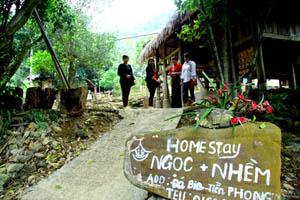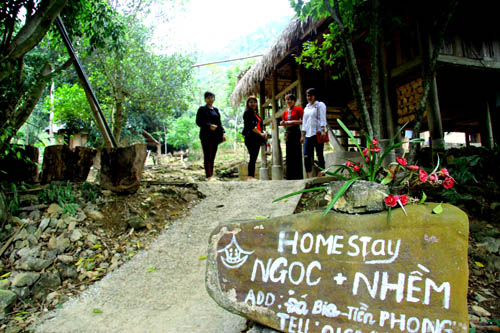
(HBO) – Magnificent mountains, primeval forests, numerous caves, magical waterfalls, and traditional cultural values of ethnic groups have all been used to boost tourism in the upland district of Da Bac.
Ke hamlet, Hien Luong commune, is next to Hoa Binh Lake, which boasts a poetic natural
landscape. In the rainy season, the water creates breathtaking waterfalls. The
hamlet has 85 Muong ethnic households. It is an interesting destination for
domestic and foreign tourists.
Homestay site at Da Bia
hamlet, Tien Phong commune (Da Bac) operating effectively
Dinh Quy Huu, from one of
the three families providing homestay services in Ke commune said foreign
visitors mainly come from France,
Sweden, Japan and the Republic of Korea,
while domestic tourists are mostly young people. Tourists want to learn about
local customs. Besides tasting traditional specialties such as "ga doi”
(chicken), "ca ho” (fish), "mang chua” (sour bamboo shoots), "ruou can” and
"ruou hoang” (wine), visitors can join farming activities, as well as cook
rice, fish, dance, cycle around the hamlet, swim, and stroll. Visitors love
walking from Ke hamlet to Ngu and Mai hamlets in Hien Luong commune, crossing
Bieu mountain to Sung hamlet in Cao Son commune – where the Dao ethnic minority
people live. These tourism activities have helped residents increase their
income and have improved their awareness of preserving culture and protecting
the environment.
Head of the culture and
sport division Nguyen Van Hien said Da Bac district has welcomed many foreign
tourists to learn about lives of local people. The Australian Foundation for
the Peoples of Asia and the Pacific (AFAP) has boosted Da Bac tourism. The
foundation supported and trained some households in homestay tourism at Ke and
Da Bia hamlets. The district’s People’s Committee has implemented policies to
support the development of community-based tourism. The district has developed
more than 10 households to provide community tourism. The AFAP also plans to
assist two families in Sung hamlet in Cao Son commune to upgrade their houses,
clean the environment, and provide community tourism services. The foundation
has also worked with one Asian travel company to bring four delegations of
tourists to Sung hamlet in July. It plans to invite 2,000-2,500 foreign
visitors annually to learn about the Dao ethnic people in Cao Son commune. Da
Bac district is building a resolution on tourism development through 2030 as
part of Hoa Binh Lake
being developed into a national tourist site. The district will also take
advantage of assistance from the province and organisations to step up
popularisation of tourism potential, and implement policies to help businesses
to develop tourism, especially eco-tourism, resort tourism, and discovery
tourism. A positive sign is that many enterprises have conducted surveys to
build tourism products./.
By Lê Chung
A diverse chain of eco-tourism and resort destinations concentrated in Hoa Binh city and the districts of Tan Lac, Da Bac, and Luong Son… Along with the launch of several key high-quality resort tourism projects, these developments have reshaped the landscape and enhanced the appeal of Hoa Binh as a travel destination.
Boasting diverse terrain, a mild climate, and rich natural resources, Cao Phong district is increasingly asserting its place on Vietnam’s tourism map, attracting both domestic and foreign visitors. The district is renowned for its stunning landscapes, majestic mountains, a crystal-clear hydropower lake, and the unique cultural identity of local ethnic groups.
With its pristine landscapes, unique cultural heritage of Muong ethnic minority, and an expanding range of visitor experiences, Tan Lac district of Hoa Binh has fast become a captivating destination for both domestic and international tourists.
Until now, Sung village in Cao Son commune, Da Bac district remains the only Dao ethnic community in Hoa Binh province to develop a community-based tourism model. Beyond its untouched natural landscapes, cultural identity serves as the cornerstone attraction for visitors.
Alongside the diverse cultural identities of the Kinh, Muong, Tay, Thai, Dao, and Mong ethnic people, Hoa Binh province is also renowned as the "capital" of the northwestern Vietnamese cuisine, offering unique and distinctive dishes. At festivals, during Lunar New Year (Tet), or on significant family or community occasions, special dishes are prepared, leaving a lasting impression on visitors.
A Phong Linh (Yellow Tabebuia) flower garden in Thang village, Thach Yen commune, Cao Phong district is currently in full bloom, drawing a large number of visitors.



